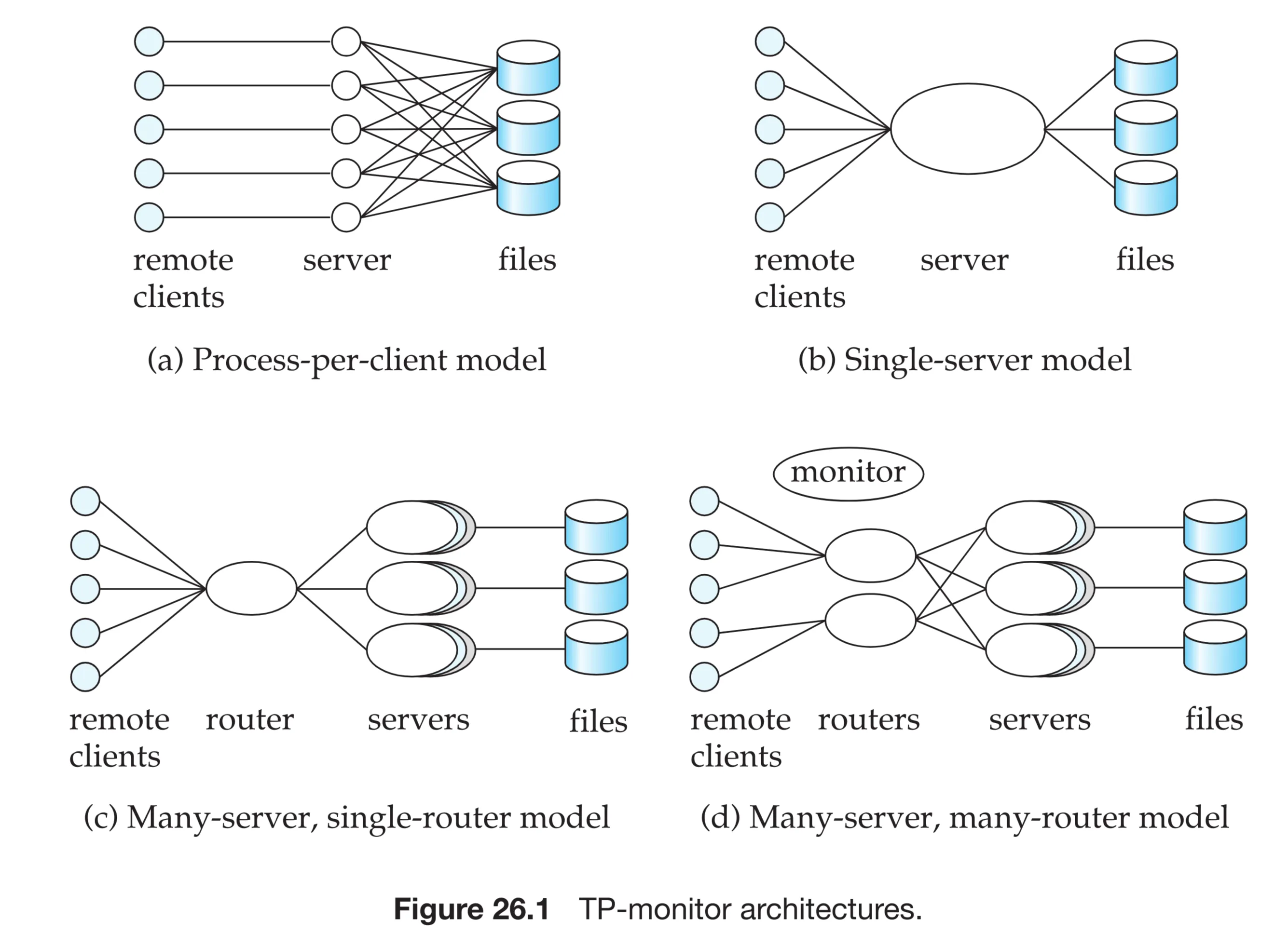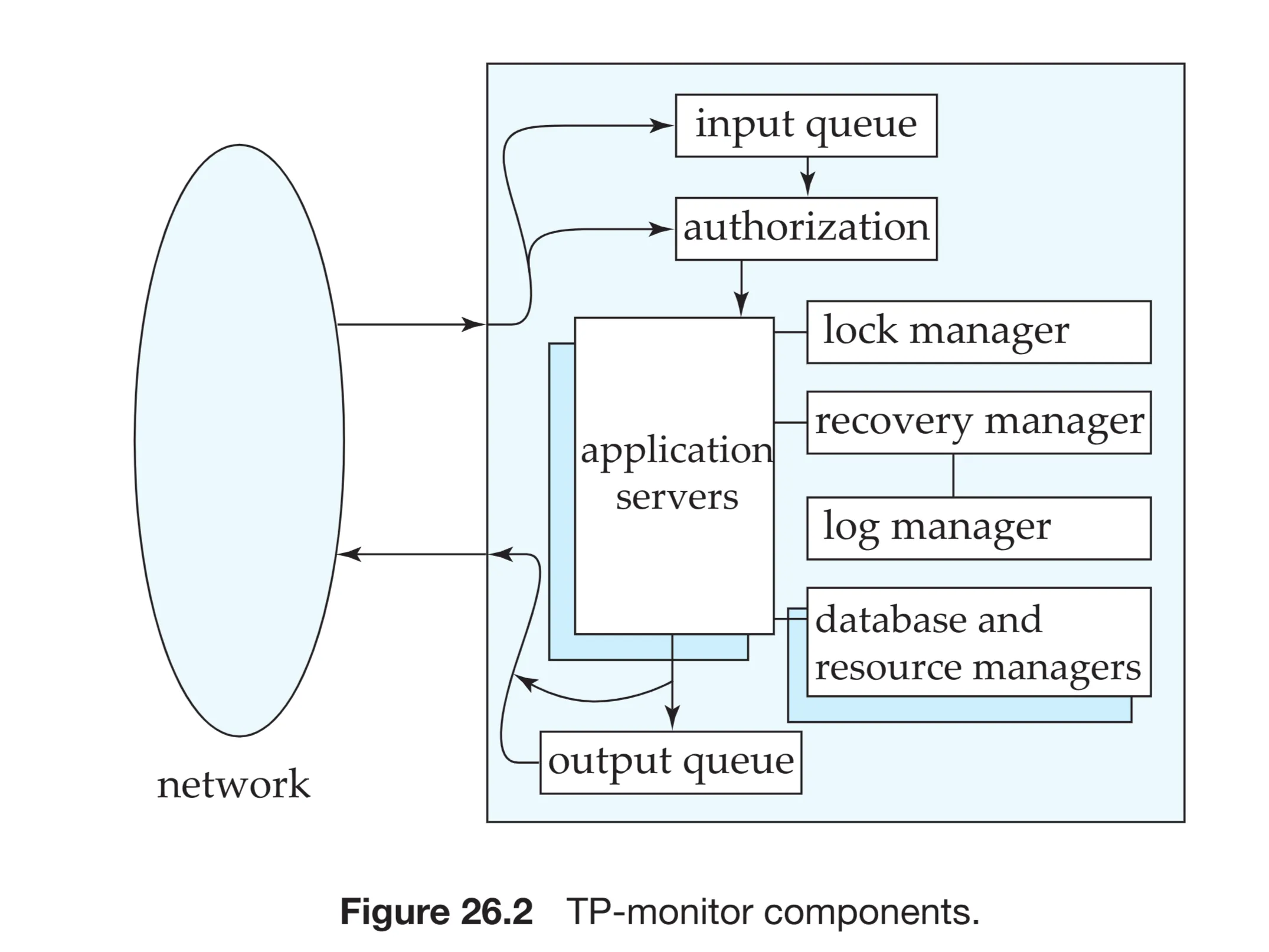GemStone Architecture: Quick Notes
- Model: Client-Server OODBMS.
- Core Processes:
- Stone (Server):
- Role: Database Engine Core.
- Runs: On Server Machine.
- Manages: Disk I/O, Concurrency, Recovery, Authorization, Object Table (maps OOPs to disk).
- Gem (Client/Server):
- Role: Application Interface / Frontend.
- Runs: Client or Server Machine.
- Handles: Compilation, Browsing, Authentication, App Logic Execution.
- Communicates with Stone to get/store objects.
- Stone (Server):
- Object Handling:
- Persistence: All objects are persistent (managed by Stone).
- Identification: Uses OOPs (Object-Oriented Pointers) - unique logical IDs.
- Mapping: Stone’s Object Table links OOPs to physical object locations (disk/memory). This allows objects to move without breaking references.
TP-Monitor Architectures: Quick Review Notes
 Overall Goal: Handle high-volume transactions efficiently, reliably, and consistently in a client-server setup.
Overall Goal: Handle high-volume transactions efficiently, reliably, and consistently in a client-server setup.
Four Models (Progression):
-
Process-per-Client Model:
- Idea: One dedicated server process for each client.
- Pros: Simple concept.
- Cons:
- HUGE Memory Use: Each process needs its own memory.
- SLOW Context Switching: OS switching between processes is expensive (hundreds of µs). Inefficient for many clients
-
Single-Server Model:
- Idea: One single server process for all clients.
- Key Tech: Uses multithreading within the server process.
- Pros:
- Less memory than Model 1.
- FAST Context Switching: Switching between threads is cheap (µs).
- Cons:
- No Protection: One bad app/thread can crash the entire server.
- Poor Scalability: Doesn’t easily scale across multiple machines (parallel/distributed DBs).
- Examples: Old CICS, NetWare.
-
Many-Server, Single-Router Model:
- Idea: Multiple server processes, one router process directs client requests.
- Key Features:
- Router distributes load.
- Can have pools of servers per application.
- Servers can still be multithreaded.
- Pros:
- Better scalability (servers on different machines).
- Supports multiple applications distinctly.
- Load balancing possible via router/pools.
- Better protection between server processes.
-
Many-Server, Many-Router Model:
- Idea: Multiple routers, multiple servers. A controller oversees.
- Key Features: Multiple entry points (routers).
- Pros:
- Highest Scalability: Handles massive client/server numbers.
- Highest Availability: Failure of one router isn’t catastrophic.
**TP Monitor Components

-
Core Idea: Manages the lifecycle of a transaction request from client to database and back.
-
Key Components & Flow:
- Input Queue:
- Receives incoming client requests.
- Can be Durable: Survives crashes, ensuring requests aren’t lost.
- Authorization:
- Checks user identity and permissions.
- Application Server Management:
- Starts/Manages application server processes/threads.
- Routes requests to the correct/available server (handles pools).
- Core Transaction Managers: (Work together)
- Lock Manager: Handles concurrency control (locking resources).
- Log Manager: Writes to the transaction log (essential for recovery).
- Recovery Manager: Uses the log to handle failures (rollback/rollforward).
- Database & Resource Managers:
- Provides the interface for application servers to access the database and other resources (files, etc.).
- Output Queue:
- Holds outgoing responses back to the client.
- Input Queue:
10) Explain how query languages (like OQL - Object Query Language) are used in object-oriented databases. How do they differ from SQL queries?
OODB Query Languages (QLs) - How Used:
- Integrated: Built into the programming language (C++/Java).
- Same Types: Uses the language’s type system (no conversion needed).
- Direct: Manipulate persistent objects directly (no explicit fetch/store code).
- Collections: Query
class extents(all objects of a class) using iterators & filters. - Complex: Specific QLs exist for queries beyond simple iteration (though OQL details weren’t in the text).
Key Differences: OODB QL vs. SQL:
- Focus:
- OODB: Objects, Classes, References (Pointers).
- SQL: Tables, Rows, Columns, Joins.
- Integration:
- OODB: Tight with host language, same types.
- SQL: Separate language, different types, needs conversion.
- Access:
- OODB: Transparent persistence (looks like normal objects).
- SQL: Explicit commands (
SELECT,INSERT, etc.).
- Style:
- OODB: Less declarative, often navigational (follow pointers), iterates.
- SQL: Declarative (specify what, not how), optimizer plans execution.
- Goals:
- OODB: High performance, seamless OOP integration, complex object handling.
- SQL: Powerful/flexible querying, data independence, protection.
Core Trade-off: OODB QLs (in persistent languages) prioritize integration/performance. SQL prioritizes declarative power/independence.
9) Design a class hierarchy for a University Database (Student, Teacher, Course, Department) using object-oriented concepts. How would you model this in an OODBMS?
Person
|-- name (structured type or varchar)
|-- address (structured type or varchar)
|-- personID (Persistent Identifier)
|
|--- Student (under Person)
| |-- Inherits: name, address, personID
| |-- studentID (specific identifier)
| |-- degreeProgram
| |-- major (ref to Department)
| |-- coursesTaken (collection of ref to Course)
|
|--- Teacher (under Person)
|-- Inherits: name, address, personID
|-- teacherID (specific identifier)
|-- salary
|-- rank
|-- department (ref to Department)
|-- coursesTaught (collection of ref to Course)
Department
|-- deptID (Persistent Identifier)
|-- deptName
|-- head (ref to Teacher)
|-- faculty (collection of ref to Teacher)
|-- coursesOffered (collection of ref to Course)
Course
|-- courseID (Persistent Identifier)
|-- courseName
|-- credits
|-- department (ref to Department)
|-- instructor (ref to Teacher)
|-- enrolledStudents (collection of ref to Student)
CREATE TYPE Person (
personID INTEGER, -- Or use system generated refs later
name VARCHAR(50), -- Could be a structured type like 'Name' if defined
address VARCHAR(100) -- Could be a structured type like 'Address' if defined
) NOT FINAL; -- Allows subtypes (Student, Teacher)
CREATE TYPE Department (
deptID VARCHAR(10) PRIMARY KEY, -- Assuming a simple key for simplicity
deptName VARCHAR(50),
head REF(Teacher) -- Reference to a Teacher object
-- Scope would be defined on the table if using O-R mapping
);
CREATE TYPE Course (
courseID VARCHAR(10) PRIMARY KEY, -- Assuming a simple key
courseName VARCHAR(50),
credits INTEGER,
department REF(Department) -- Reference to the offering Department
);
-- Define Subtypes using Inheritance (Student, Teacher)
CREATE TYPE Student UNDER Person (
studentID VARCHAR(10) PRIMARY KEY, -- Specific ID for Student
degreeProgram VARCHAR(50),
major REF(Department), -- Reference to the Student's major Department
coursesTaken MULTISET(REF(Course)) -- Collection of references to Courses
);
CREATE TYPE Teacher UNDER Person (
teacherID VARCHAR(10) PRIMARY KEY, -- Specific ID for Teacher
salary INTEGER,
rank VARCHAR(20),
department REF(Department), -- Reference to the Teacher's Department
coursesTaught MULTISET(REF(Course)) -- Collection of references to Courses
);